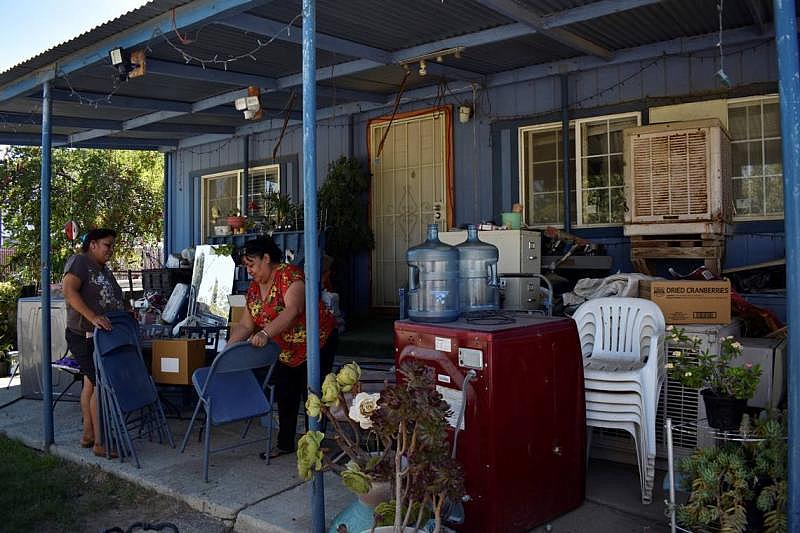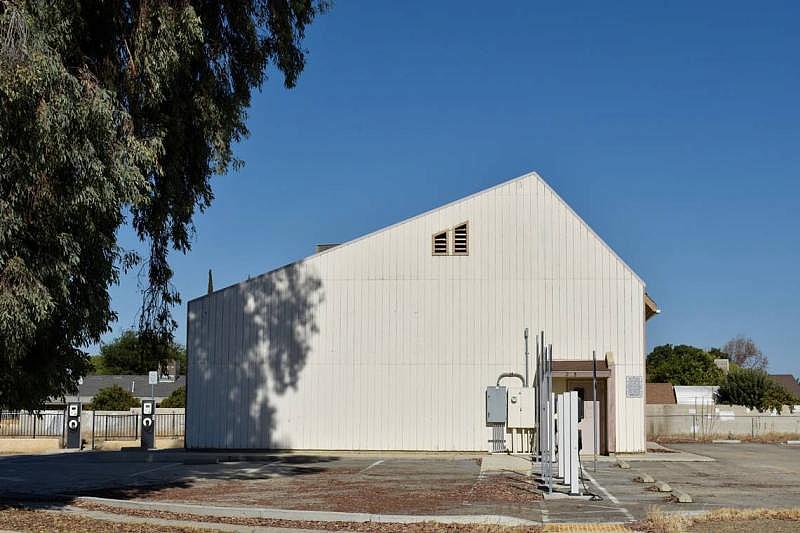Imagine Fresno County’s summer heat with no cooling centers. Some live that every day
The story was originally published in The Fresno Bee with support from the USC Annenberg Center for Health Journalism's 2022 California Fellowship.

Blanca Gomez sits inside her trailer home in Cantua Creek, an unincorporated community in Fresno County, on Aug. 19, 2022. Despite having 10 fans, a swamp cooler and a small air-conditioning unit in her bathroom, she gets little relief from the triple-digit heat inside her home.
LDIAZ@FRESNOBEE.COM LAURA S. DIAZ
By LAURA S. DIAZ and CASSANDRA GARIBAY
To read this story in Spanish, click here.
This story is part of a series produced by Fresnoland and the Central Valley News Collaborative, exploring the impact of climate change on various populations within the central San Joaquin Valley, particularly those most vulnerable to these extreme weather conditions.
Blanca Gomez has a swamp cooler, 10 fans and a small air conditioning unit in her trailer home in Cantua Creek, an unincorporated community in Fresno County.
“It’s very hard to sleep when it’s hot,” Gomez said in Spanish. “I sometimes shower at 1 a.m. to cool down, and even with three fans in my room, it isn’t enough.”
On Aug. 19 at 3:30 p.m., the temperature inside her home varied between 84 and 87 degrees. It was humid and hot, suffocating, almost. She debated whether she should remain inside with the curtains drawn, or sit outside on her front porch or across the street in a shaded, abandoned parking lot.
Like Gomez, many residents of Fresno County’s unincorporated communities are suffering from the heat. The Fresno area has seen 91 days over 90 degrees so far this year; 50 of those days have reached triple digits.
And when temperatures soar in the summer, these residents have few places to turn. The county government does not activate any dedicated cooling centers during periods of extreme heat, and state officials explained they can’t force county or local governments to do so.
In the absence of dedicated cooling centers, county representatives suggest residents of unincorporated communities cool off at existing air-conditioned facilities like libraries and community centers.
They have also suggested that all residents have to do is ask for a cooling center, but have not presented a clear path to do so. Further confusing residents, a spokesperson for the Fresno County Department of Public Health also said, “each community makes decisions about whether or not to have a cooling center and where to place them if public buildings are available.”
Either suggestion has provided little relief to Gomez. Community members have asked their county supervisor for a cooling center, but he’s told them they’ll have to fund it through the taxes they pay for county services provided in Cantua Creek.
In the meantime, the unincorporated community of Tranquillity, about 13 miles away from Cantua Creek, has an air-conditioned library open four days a week, four hours each day. But Gomez said she has no way of getting there. She doesn’t drive — and even if she did, many residents of her low-income, agricultural community cannot afford the gas needed to make the trip.
HOW FRESNO COUNTY HANDLES EXTREME HEAT
There were six heat-related deaths in Fresno County in 2021, according to the California Department of Public Health. Fresno County Emergency Medical Services responded to nearly 350 calls for heat-related emergencies last year, and more than 200 this year as of mid-August.
During periods of extreme heat — which the county defines as when temperatures go above 90 degrees for two to three consecutive days — the county suggests that residents stay indoors in air-conditioned areas or find a cool place.
But cool places can be hard to find.
The city of Fresno activates four cooling center locations — existing community centers — when temperatures reach 105 degrees or more. During these periods of extreme heat, the city’s bus system provides free transportation to the four centers and pets are allowed in the facilities as well.
The county’s website lists 15 additional sites in Fresno, mainly parks and pools, where city residents can find relief from the heat.
The city of Clovis operates one cooling center, which is located in the lobby of the police and fire department headquarters.
Resources for unincorporated county communities are even fewer and farther between.
A spokesperson for Supervisor Brian Pacheco said that in District 1, which includes Cantua Creek, there are cooling centers in the incorporated cities of Firebaugh and Mendota. He said there are also cooling centers in the unincorporated communities of Biola and Tranquility (a community hall and a library, respectively). But these are simply county facilities with air conditioning; the facilities’ hours do not change when temperatures soar, nor do they provide any additional cooling services, county staff confirmed.

Julia Mendoza, left, and Blanca Gomez, right, wipe the dust off folding chairs at Gomez’s home on Aug. 19, 2022. When they can’t find relief from the heat inside Gomez’s home or on her front porch, the two friends sit under a tree in an abandoned parking lot. ldiaz@fresnobee.com LAURA S. DIAZ
Terri Mejorado, Fresno County’s emergency manager, said the county Office of Emergency Services would not typically set up cooling centers on extremely hot days, unless there are potentially extenuating circumstances, such as mass power outages or drinking water issues as a result of the heat.
It’s “normally” up to the cities or smaller unincorporated areas to support their own cooling centers, she said.
“If their community does not have (a cooling center), I would encourage them to go speak to somebody within that area to see if they can get one,” Mejorado said.
Part of the reason there are so few cooling centers in Fresno County is that neither the state nor the county is required to provide access to cooling centers or resources like water, snacks or heat-related advice and information.
“If you’re looking for a law looking for specific requirements, I don’t think you’re going to find it,” said Brian Ferguson, the deputy director for crisis communication at the California Office of Emergency Services. The California Department of Public Health confirmed via email that the state does not have any requirements for counties or cities to operate cooling centers.
Ferguson said the state wouldn’t be able to require operations at a county or city level without providing funding for those resources or it would be considered an “unfunded mandate.”
However, funding opportunities that could create or improve cooling center protocols are on the horizon.
Grant funding for resiliency centers — cooling centers with extra resources — was approved in 2021 as part of a $15 billion climate budget package. The Integrated Climate Adaptation and Resiliency Program is developing a grant that local jurisdictions could apply for that is specifically aimed at preparing for extreme heat.
COMMUNITY LACKS COOLING CENTER DURING EXTREME HEAT
The only public spot with shade in Cantua Creek is under a single tree in the parking lot of an abandoned county building. Though there are other trees in front of porches of houses and trailer homes, public shade is minimal.
“You see many cooling centers in Fresno,” Gomez said. “There, they have water for kids to play in. Here, there is no park. Many years ago there used to be a playground and now, nothing.”
Besides lacking a park, Cantua Creek also lacks a community center. Yet, there is an old, abandoned county-administered building sitting right across from Gomez’s home. She said the former fire station could be converted into an air-conditioned community center.
“Fortunately, we have a place where we could have a center, but unfortunately it is not in service,” Julia Mendoza, Gomez’s friend and neighbor, said in Spanish. “That is the saddest thing, that there is a place, but there is no one that considers us for a center.”
However, the building may not be as easy to repurpose as Cantua Creek residents might want.

An old, abandoned, county-administered building sits in the middle of Cantua Creek, an unincorporated community in Fresno County. The tree in the public parking lot is the largest around and the only one that provides a patch of shade wide enough for the community to find relief from triple-digit heat. ldiaz@fresnobee.com LAURA S. DIAZ
Pacheco said the building is owned by CSA 32, Cantua Creek’s local county service area. This means that the residents own the property through the county’s Special Districts Administration, a division of the Department of Public Works and Planning.
CSA residents can vote on community services for which they want to tax themselves, Pacheco said.
“The community would have to set up a fee structure for them to pay for the ongoing operation of that building,” Pacheco said. “The residents have to decide whether to tax themselves or not.”
With electric bills ranging between $200 to $250 a month, on top of other living expenses, community members cannot afford additional fees, Gomez and Mendoza said.
Pacheco said a pistachio company plans to start operating in the area, and suggested that the company may be persuaded to help residents operate the potential cooling center.
But community members want more concrete plans.
“We pay taxes, just like those residents who have those luxuries, who have access to those cooling centers,” Mendoza said. “We’re forgotten; the county has left us very forgotten here.”
The Central Valley News Collaborative and Fresnoland are collaborating on a series of stories about how climate change is affecting the Central Valley. Cassandra Garibay helped report this story while participating in the USC Annenberg Center for Health Journalism’s 2022 California Fellowship.

